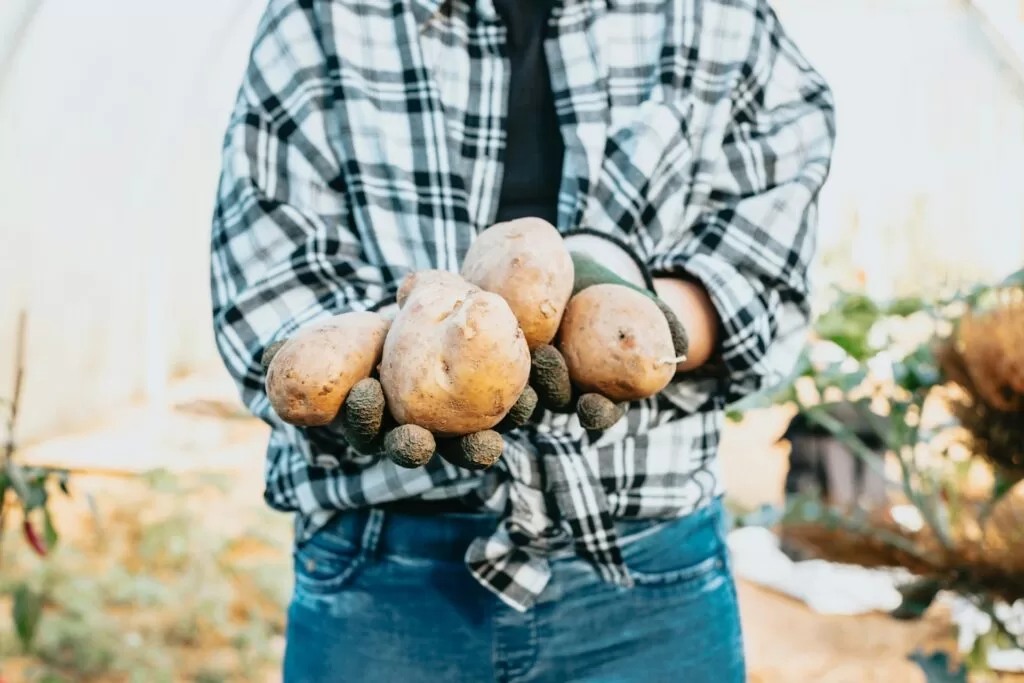Happy Eco News Scientists Engineer Climate-Proof Potato That Thrives in Heat
Reading Time: 3 minutes
New research on climate-proof potato varieties shows promise for farming in increasingly warm conditions.
Scientists have developed a new type of climate-proof potato that doesn’t just survive in extreme heat – it thrives. These modified potatoes grow up to 30% larger than regular potatoes during heatwaves, potentially offering a solution for food security in a warming world.
The discovery comes from researchers working on the RIPE project, which focuses on improving photosynthesis in food crops. Their work tackles a common problem in plant growth that worsens as temperatures rise.
This development could be transformative for potato farmers like Maria Hernandez in Idaho. In recent years, her farm has experienced approximately 15% crop losses due to heat stress, highlighting how a climate-proof potato variety could mean the difference between a profitable season and significant losses.
The secret lies in fixing a flaw in photosynthesis, the process plants use to convert sunlight into energy. During photosynthesis, a crucial enzyme called Rubisco sometimes makes a mistake. Instead of grabbing carbon dioxide molecules to create energy, it grabs oxygen.
This mistake creates a toxic substance called glycolate. Plants must then use extra energy to clean up this toxin, reducing their growth potential by 20% to 50%.
The problem gets worse in hot weather. As temperatures rise, Rubisco makes this mistake more often – about 25% of the time during normal photosynthesis.
Scientists added two genes to potato plants to solve this issue: glycolate dehydrogenase and malate synthase. These genes create a shortcut that handles the toxic glycolate right where photosynthesis happens, in the plant’s chloroplasts.
This prevents the toxin from spreading throughout the plant cell, saving the plant energy by not having to deal with a widespread cleanup process.

Before these climate-proof potatoes can reach farmers’ fields, they must undergo extensive regulatory review. The process typically takes 5-7 years in the United States and involves safety assessments by the FDA, USDA, and EPA. Similar approvals will be needed in other countries.
To test their innovation, researchers grew these modified potatoes in open fields during two growing seasons – 2020 and 2022. They compared them with regular potatoes during natural heatwaves that lasted almost a week.
The results were impressive. The modified potatoes showed better photosynthesis performance and fixed more carbon into energy. They grew 9% to 30% larger than regular potatoes. Importantly, they maintained normal fiber, vitamin C, and protein levels.
This breakthrough holds particular significance because potatoes are a crucial global food source. They rank as the most important non-grain crop worldwide and match rice and maize in calories produced per land area. Potatoes serve as a basic food staple in many countries.
According to the World Food Security Alliance, the potential impact of these climate-proof potatoes extends far beyond individual farms. With 828 million people facing hunger globally, crops that can withstand extreme weather could help stabilize food supplies in vulnerable regions. These heat-resistant potatoes could become an essential tool in addressing global food insecurity.
The implementation of climate-proof potato varieties could reshape agricultural practices in heat-vulnerable regions. Small-scale farmers in regions like Sub-Saharan Africa and South Asia, where temperatures frequently exceed optimal growing conditions, stand to benefit significantly. Even a modest increase in potato yields could improve food security and economic stability for farming communities in these areas.
The technology’s potential extends beyond increasing crop yields. Current estimates suggest that farmers spend between 15% and 20% of their irrigation resources on crops stressed by extreme heat. Climate-proof potatoes could reduce water requirements during heatwaves, leading to substantial water conservation in agriculture—a critical consideration as water resources become increasingly scarce in many regions.
Agricultural economists project that the global impact of heat-resistant crop varieties could prevent billions in losses annually. The potato industry alone faces yearly losses of approximately $1.2 billion due to heat-related crop failures. Climate-proof varieties could help stabilize these losses while potentially reducing food price volatility in heat-affected regions.
Seed companies and agricultural organizations are already expressing interest in licensing the technology once regulatory approval is secured. This commercial interest could accelerate the distribution of climate-proof potato varieties to farmers worldwide, though accessibility and affordability in developing regions remain important considerations.
Looking ahead, scientists plan to test these results in different locations worldwide. They aim to apply the same modification to other similar crops like cassava. Their ultimate goal is developing more crops that can handle frequent, intense heatwaves.
The research represents a significant step toward creating “climate-ready crops” that can help maintain food supplies as global temperatures rise. As extreme weather events become more common, innovations like these climate-proof potatoes could be crucial in protecting the world’s food supply.
The post Scientists Engineer Climate-Proof Potato That Thrives in Heat appeared first on Happy Eco News.
